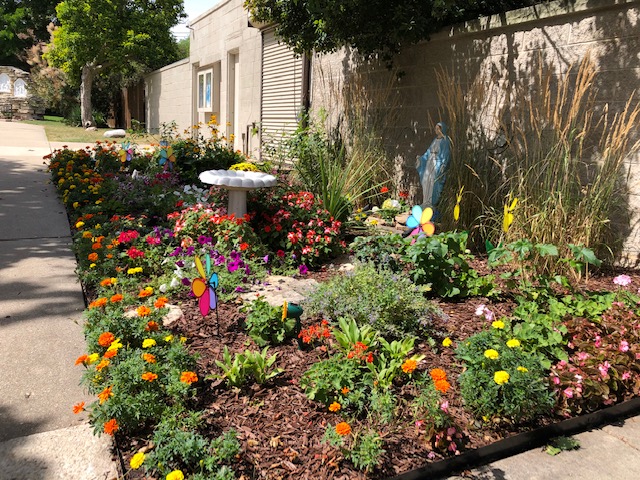Milwaukee Catholic Mamas

A Marian Garden can serve as a witness to your family’s Catholic Faith. (Submitted photo)
It’s the season for blooming flowers, sunlit evenings and the return of the smell of freshly mowed grass. As the natural world starts to reawaken after a long winter’s nap, why not consider adding a traditional Marian garden to your family’s outdoor space?
Marian gardens are not only a beautiful way to honor our Blessed Mother through the beauty of God’s creation, but they also serve as a simple witness to the outside world of your family’s Catholic faith.
For Mary Homan, a parishioner at Three Holy Women Parish in Milwaukee, Marian Gardens have been a staple of her living space in every home she has had — from Missouri to Kansas to Oklahoma and finally to Wisconsin. “My parents gave me a Mother Mary statue when I bought my first house at the age of 25,” said Homan. “She has literally been a touchstone of my life and in my various houses. I love to just take a couple minutes to sit and be in Mary’s presence.”
When Homan and her family moved to their current home in Wauwatosa, she placed the statue near a large oak with hydrangea, day lilies, boxwoods and irises. Last summer, she added a bench to make quiet prayer time easier, and her son Blake assisted in selecting additions to the garden space.
“We both love the colors purple and blue, and I found them to be very fitting for Mary — both royalty and hope,” said Homan. “Blake picked out campanula or bellflower, which I subsequently discovered is a symbol of gratitude or everlasting love.”
There is no real formula for what a “Mary Garden” should look like, said Maryann Penkal, a volunteer at the Archdiocesan Marian Shrine on North 68th Street in Milwaukee. The gardeners themselves will be the best experts at choosing flowers and shrubs that speak to their own devotion to the Blessed Mother.
“I think any plant that a person feels adds beauty and honors Mary is appropriate,” said Penkal, who tends to a special section of the shrine that is removed from the main altar but which features a Marian statue. “Plant selection depends on the gardener’s experience and site location.”
For Penkal and her husband John, as well as the other family members who tend to the site in memory of Penkal’s sister Julie Busch, the most important feature of any plant is resistance to rabbits.
“Even in the city, we can have the new buds nibbled down and never get to produce any flowers if the rabbits have it their way,” she said. “Next, we have incorporated perennials such as lavender, Hostas, roses, purple coneflower, iberis, anemone, catmint, marigolds, ornamental grasses and delphinium.”
Penkal advised that while tulips are lovely and often a favorite Marian Garden plant, they tend to be short-lived, so she prefers daffodils.
“Hostas and daylilies are easy to grow,” she said. “Really, choosing the right plant for the right place is the key to gardening success. How much sun, drainage, soil fertility and shelter is there? The traditional Mary flowers may be fine depending on the site selected; otherwise a mixture of plants that thrive is a great option, I think.”
More tips for planning your Mary Garden
Involve the kids: Many families place their Marian Garden in a spot where the children can easily “visit Mary” for a short break from playtime. It helps encourage spontaneous opportunities for prayer and reflection, and helps to plant the seeds (pun intended) for a Marian devotion in the child. Kids of all ages will also enjoy helping to select plants for the garden, and tending to it can be a family activity. Make it a tradition to say a Hail Mary as you weed and water.
“Blake will often just come and sit quietly next to (Mary) and we’ll often offer up a Memorare, my go-to Mary prayer,” said Homan. “We have a footpath from the driveway through the garden so we wave hello to Mary a couple times a day, so it makes the garden more of a second room than anything else.”
Consult the internet: As always, the internet is a wealth of information when it comes to plants that are traditionally incorporated into a Marian Garden. Googling “Mary Garden plants” will yield a host of graphics and articles detailing what kinds of plants have been associated with the Blessed Mother throughout history. Here are just a few examples: Bleeding Hearts (known in Italy as “cuore di Maria”) represent her sorrow at the Crucifixion, lilies have long symbolized both her own purity and that of St. Joseph, and roses are often associated with her queenship of Heaven and the prayers we offer to her (the rosary is so named because each prayer is like a rose offered at her feet). The University of Dayton has a page devoted to the “Mary’s Gardens movement” of the 1950s and the research of Marian-associated plants. Visit udayton.edu/imri/mary/j/john-stokes-and-marys-gardens.php.
